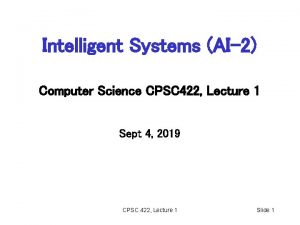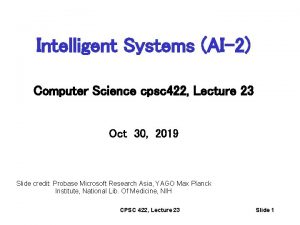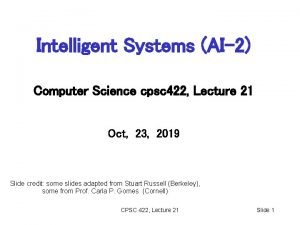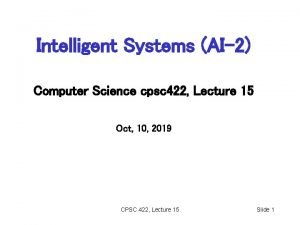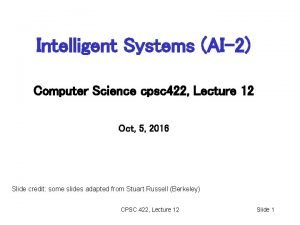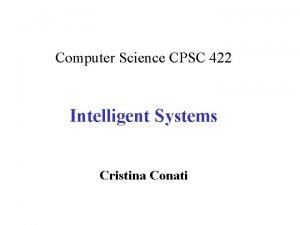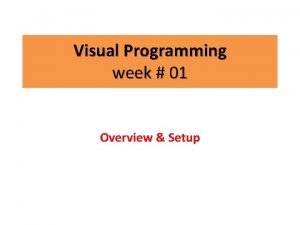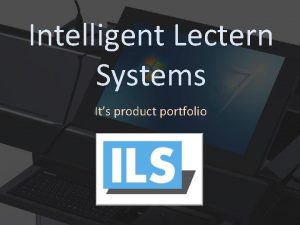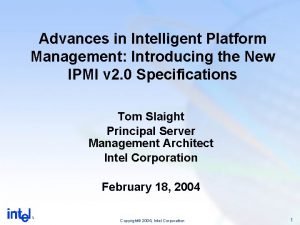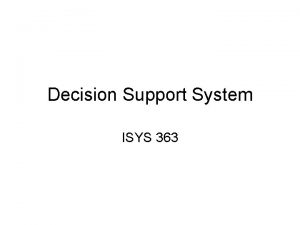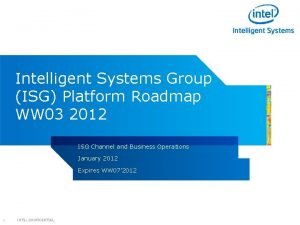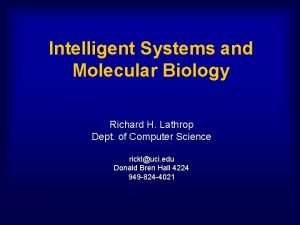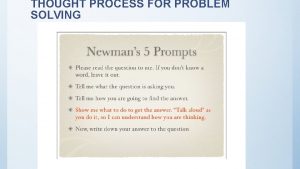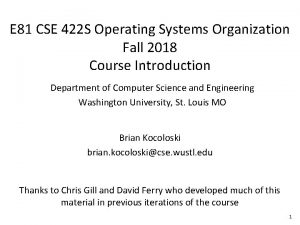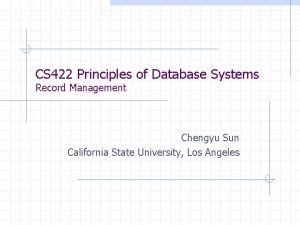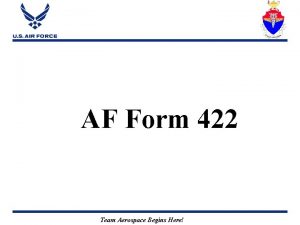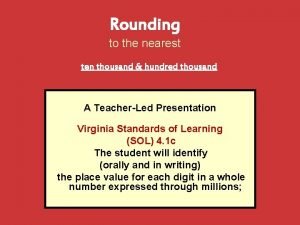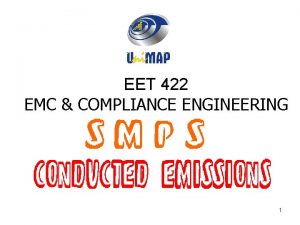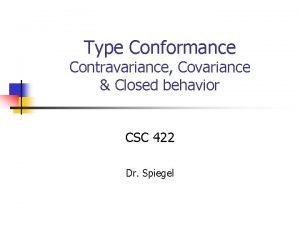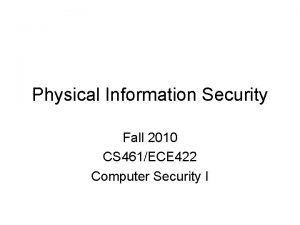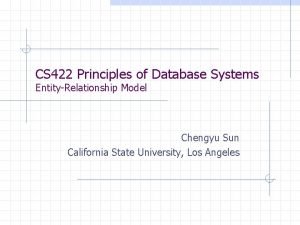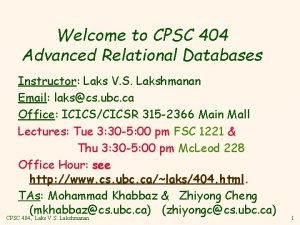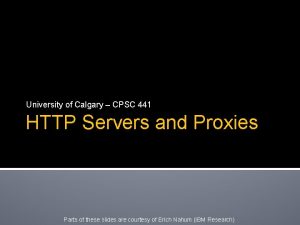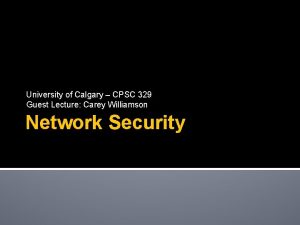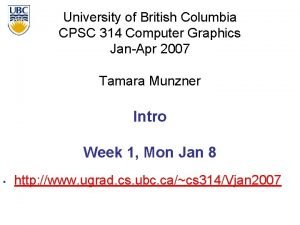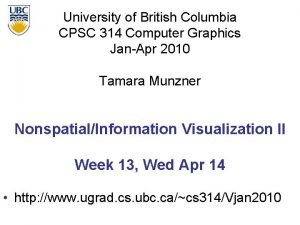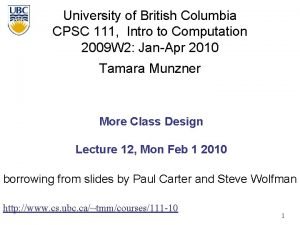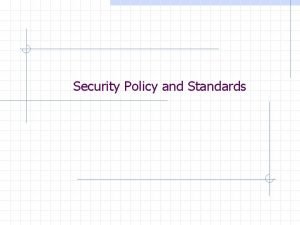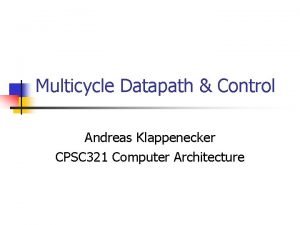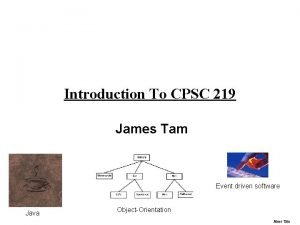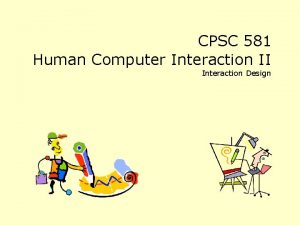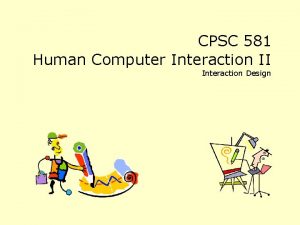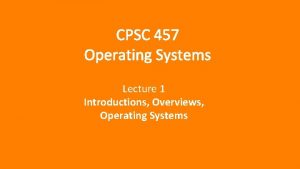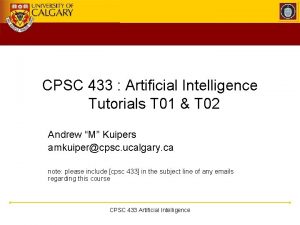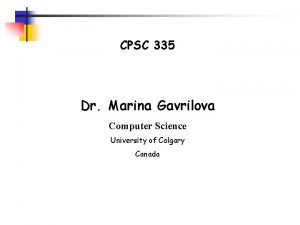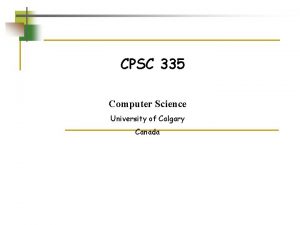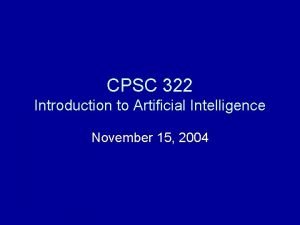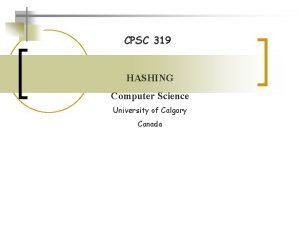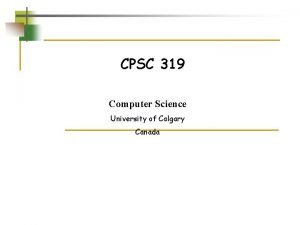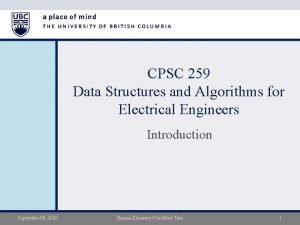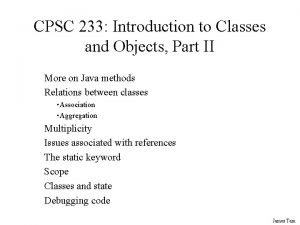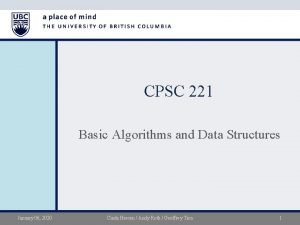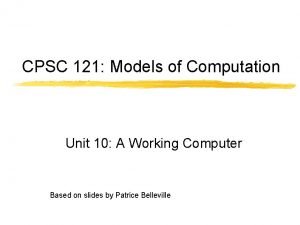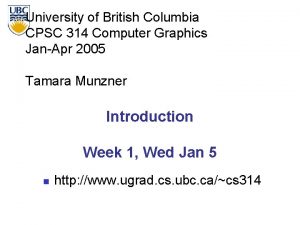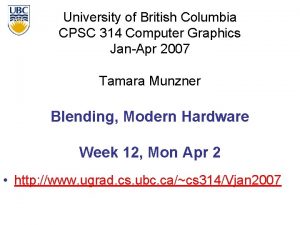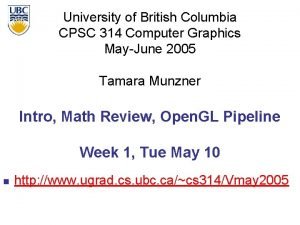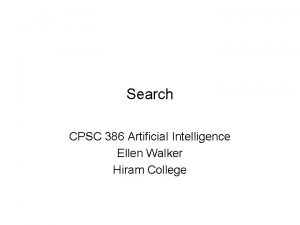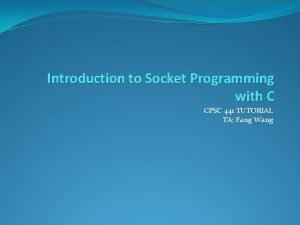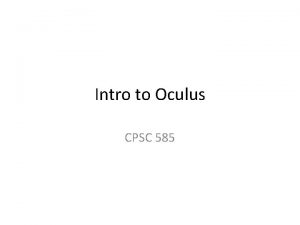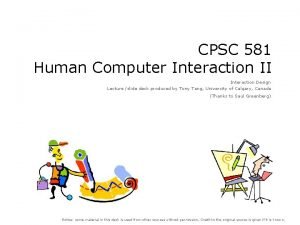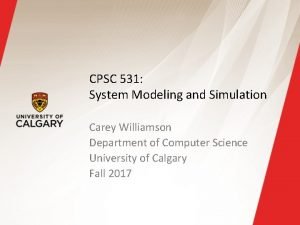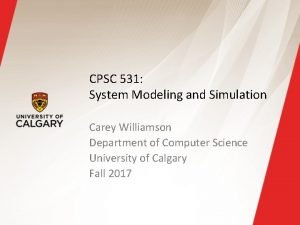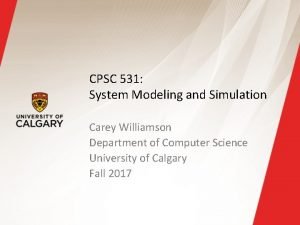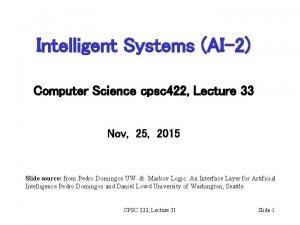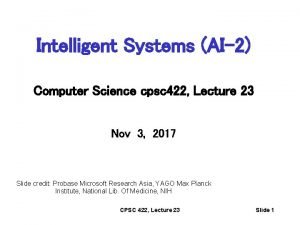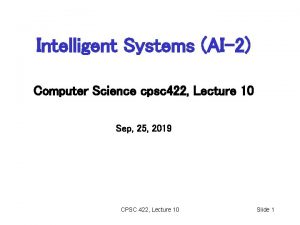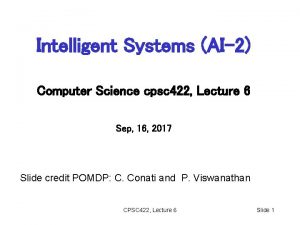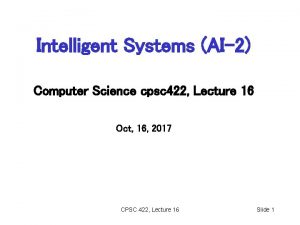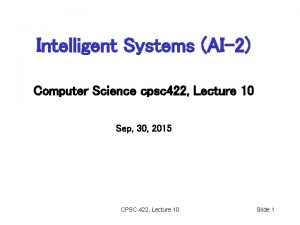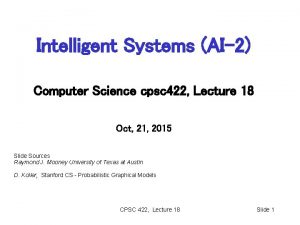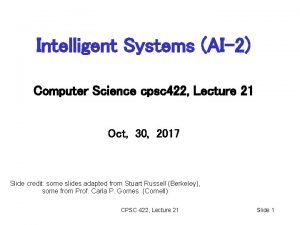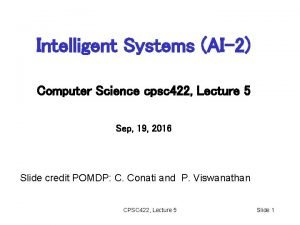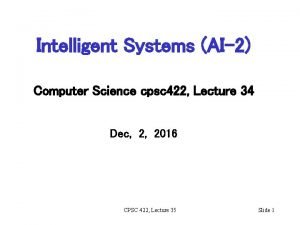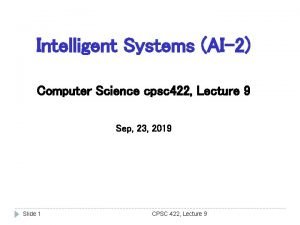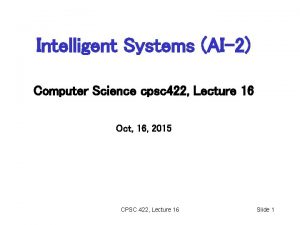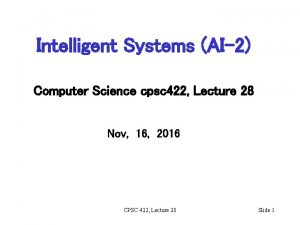Intelligent Systems AI2 Computer Science cpsc 422 Lecture





































































- Slides: 69

Intelligent Systems (AI-2) Computer Science cpsc 422, Lecture 29 Nov, 17, 2017 CPSC 422, Lecture 28 Slide 1

422 big picture: Where are we? Hybrid: Det +Sto Deterministic Stochastic Prob CFG Prob Relational Models Markov Logics Belief Nets Logics First Order Logics Ontologies Query • • Planning Full Resolution SAT Approx. : Gibbs Markov Chains and HMMs Forward, Viterbi…. Approx. : Particle Filtering Undirected Graphical Models Markov Networks Conditional Random Fields Markov Decision Processes and Partially Observable MDP • Value Iteration • Approx. Inference Reinforcement Learning Applications of AI CPSC 422, Lecture 28 Representation Reasoning Technique Slide 2

NLP: Knowledge-Formalisms Map (including probabilistic formalisms) State Machines (and prob. versions) Morphology Syntax Semantics Pragmatics Discourse and Dialogue (Finite State Automata, Finite State Transducers, Markov Models) M a Neural Models, Neural Sequence c Modeling h Rule systems (and prob. versions) i (e. g. , (Prob. ) Context-Free Grammars) n e Logical formalisms (First-Order Logics, Prob. Logics) L e a AI planners (MDP Markov Decision Processes) CPSC 422, Lecture 28 3 r n i n g

Discovering Discourse Structure: Computational Tasks The bank was hamstrung in its efforts to face the challenges of a changing market by its links to the government, analysts say. Discourse Segmentation The bank was hamstrung in its efforts 1 to face the challenges of a changing market by its links to the government, 2 Discourse Parsing CPSC 422, Lecture 28 analysts say. 3 4

Some general points • Intelligent Systems are complex; often integrating many R&R systems + Machine Learning • Conditional random fields, Syntactic parsing / Wordnet / Lexical Chains, Logistic regression…. • Discourse Parsing is a task we are very good at, here at UBC ; -) – 2 grad students working on/with it right now – (several in the past) • Demo CPSC 422, Lecture 28 5

Applications • Detect Controversiality in online asynchronous conversations - 2014 • Summarize evaluative text (e. g. , customer reviews) (journal paper 2016) • "Using Discourse Structure Improves Machine Translation Evaluation“ ACL 2014 • Others ACL 2017 improvements in text categorization Uof. W Some recent extensions • Coling 2016 – Semi-supervised data enrichment • Sig. Dial 2017 – joint neural model with Sentiment CPSC 422, Lecture 28 6

Current Work My group • Improve on Coling paper – using a framework called data programming (Smart ensembling based on graphical models) • Applied discourse features in detecting dementia from user generated text (did nto work ) CPSC 422, Lecture 28 7

State-of the art 2017 CPSC 422, Lecture 28 8

Graph Structure • Example 4. 33 (1) Mr. Baker’s assistant for inter-American affairs, Bernard Aronson, (2) while maintaining (3) that the Sandinistas had also broken the cease-fire, (4) acknowledged: (5) “It’s never very clear who starts what. ” CPSC 422, Lecture 28 9

Some Questions CPSC 422, Lecture 28 10

Some Questions • " Our discourse parser assumes that the input text has been already segmented into elementary discourse units. " Why do we need this kind of assumption? • What is is the disadvantage when using DCRFs for sequence modelling compared to Hidden Markov Models and MRFs? • method works for blogs or emails • Could this be easily modified to detect the unnecessary words/sentences of a body of text? • Discourse structure can also play important roles in sentiment analysis". Is there any work in progress in your. CPSC lab that is related to this? 422, Lecture 28 11

Some Questions • Features, n-grams, • also seperately parse for DT of distinct paragraphs before building the final K probable discourse trees for the document? • Graph structure of discourse • How can the document parser account for different writing styles? ie • aren't issues like "leaky boundaries" much more likely to arise in less formal writing, like a short story, than in a how-to-do manual? • CPSC 422, Lecture 28 12

Our Discourse Parser Discourse Parsing State of the art limitations: • Structure and labels determined separately • Do not consider sequential dependency • Suboptimal algorithm to build structure Our Discourse Parser addresses these limitations • Layered CRFs + CKY-like parsing CPSC 422, Lecture 28 13

Our Parsing Model structure and label jointly R 2 W 1 R 3 -- Rj -- Rk-1 Rk S 2 S 3 -- Sj -- Sk-1 Sk W 2 W 3 -- Wj -- Wk-1 Wk Relation at level i R ϵ {1. . M} Structure at level i S ϵ {0, 1} Spans at level i Dynamic Conditional Random Field (DCRF) [Sutton et al, 2007] Models sequential dependencies CPSC 422, Lecture 28 14

Discourse Parsing: Evaluation Corpora/Datasets RST-DT corpus (Carlson & Marcu, 2001) • 385 news articles -Train: 347 (7673 sentences) -Test: 38 (991 sentences) Instructional corpus (Subba & Di-Eugenio, 2009) • 176 how-to-do manuals 3430 sentences Excellent Results (beat state-of-the-art by a wide margin): [EMNLP-2012, ACL-2013] CPSC 422, Lecture 28 15

Discourse Parsing: Example • What is the main claim in a message and how it is expanded/supported by the other claims “It would be great to hire Mary. Even though she may initially need some coaching , her background is perfect for the job. ” MAIN-CLAIM It would be great to hire Mary. EVIDENCE her background is perfect for the job. CONCESSION Even though, she may initially need some CPSC 422, coaching Lecture 28 16

Discourse Parsing Task Assume a text is already segmented into EDUs. e 1 e 2 e 3 Discourse parsing Label Structure Relation + Nuclearity r 1 -3 r 2 -3 e 1 e 2 e 3 CPSC 422, Lecture 28 e 1 e 2 e 3 17

Observations (1) • Nb of valid trees grows exponentially with the Nb of EDUs. ? Leaky • 80% of the 5% merge with • More than 95% sentences the adjacent sentences. • Sliding window: build DTs for two adjacent sentences. have a well-defined DT. • Build DTs for sentences first, then build on top of those. CPSC 422, Lecture 28 18

Observations (2) • Single model or two different models? • Relations are distributed differently. • Features don’t generalize. CPSC 422, Lecture 28 19

Previous Work (1) Hernault et al. (2010) Soricut & Marcu, (2003) SPADE Sentence level HILDA Segmenter & Parser Generative approach Lexico-syntactic features Structure & Label dependent Sequential dependencies Hierarchical dependencies Document level √ √ Х Х Х Segmenter & Parser Discriminative approach Structure & Label Jointly Optimal Sequential dependencies Separate models √ Х Х Newspaper (WSJ) articles CPSC 422, Lecture 28 21

Previous Work (2) Feng & Hirst, (2012) Subba & Di-Eugenio, (2009) Only Parser HILDA Shift-reduce More linguistic features Sentence + Document level Dependency & constituency Contextual Discourse rules Lexical similarity Cue phrases ILP-based classifier Compositional semantics Optimal Sequential dependencies Hierarchical dependencies Separate models WSJ articles √ √ Х Х Instructional manuals CPSC 422, Lecture 28 22

Requirements from Our Parser • • • Joint modeling of structure and relation Sequential and hierarchical dependencies Discriminate intra- vs. multi-sentential parsing Handle leaky sentence boundaries Optimal parsing algorithm Support k-best discourse parsing and reranking CPSC 422, Lecture 28 23

Our Discourse Analysis Framework: CODRA Parser Segmenter Doc Segmentation model Alg. Model EDUs (Max. Ent) Intra. Sentential DT Multi. Sentential Human: 98. 3 (F-score) Our (state-of-the-art): 90. 1 CPSC 422, Lecture 28 24

Our Discourse Parser Parsing model (different for intra- and multi-sentential) R 1 -3 Assign probabilities to candidate DTs and their constituents. R 1 -3 R 2 -3 e 1 e 2 R ranges over set of relations R 1 -2 e 3 e 1 e 2 e 3 Parsing algorithm (same for intra- and multi-sentential) r 1 -3 Find the (k-)most probable DT(s) r 1 -2 e 1 e 2 e 3 CPSC 422, Lecture 28 25

The Sentence-level Parsing Model Structure and label jointly R 2 S 2 W 1 W 2 R 3 S 3 W 3 -- -- -- Sequential dependencies Rj Sj Wj -- -- -- Rt-1 St-1 Wt-1 Rt Relation at level i R ϵ {1. . M} St Structure at level i S ϵ {0, 1} Wt Units at level i Dynamic Conditional Random CPSC 422, Field Lecture 28(DCRF) [Sutton et al, 2007] 26

Obtaining Probabilities (Sentence-level) Apply DCRF recursively at different levels and compute posterior marginals of relation-structure pairs Level 1 e 1 Level 2 e 1 -2 R 3 R 4 S 2 S 3 S 4 e 2 e 3 e 4 P(R 2, S 2=1|e 1, e 2, e 3, e 4, Ɵ) P(R 3, S 3=1|e 1, e 2, e 3, e 4, Ɵ) P(R 4, S 4=1|e 1, e 2, e 3, e 4, Ɵ) R 3 R 4 R 2 -3 R 4 R 2 R 3 -4 S 3 S 4 S 2 -3 S 4 S 2 S 3 -4 e 3 e 4 e 1 e 2 -3 e 4 CPSC 422, Lecture 28 e 1 e 2 e 3 -4 27

Obtaining Probabilities (Sentence-level) Apply DCRF recursively at different levels and compute posterior marginals of relation-structure pairs Level 3 e 1 -3 R 4 R 2 -4 R 3 -4 S 2 -4 S 3 -4 e 1 CPSC 422, Lecture 28 e 2 -4 e 1 -2 e 3 -4 28

Multi-sentential Parsing • Why not the same model used for intra-sentential? § “Fat” chain-structure=> exact inference=> Forwards-backwards § Forwards-backwards costs O(TM 2) for a sequence. § # of possible sequences for a doc. with n sentences: O(n 3) § Total training cost: O(D TM 2 n 3) Not scalable to document-level CPSC 422, Lecture 28 29

Multi-sentential Parsing Model Rt St Wt-1 Wt Relation R ϵ {1. . M} Structure S ϵ {0, 1} Units at level i • Model structure and label jointly • Break the chainstructure • CRF • Inference costs O(M 2) • Allows balancing Dramatically reduces learning time CPSC 422, Lecture 28 30

Features Used in Parsing Models Hierarchical dependencies CPSC 422, Lecture 28 31

Parsing Algorithm (1) Probabilistic CKY-like bottom-up algorithm 4 Х 4 4 EDUs A R ranges over set of relations Finds global optimal CPSC 422, Lecture 28 32

Parsing Algorithm (2) A CPSC 422, Lecture 28 33

k-best Parsing • Extension to k-best is straight-forward • Store and keep track of k-best candidates at each step • Complexity for n discourse units and M relations 1 -best parsing Time: O(n 3 M) Space: O(n 2) k-best parsing Time: O(n 3 Mk 2 log k) Space: O(n 2 k) • See (Huang and Chiang, 2005) for cleverer ways to reduce the complexity. CPSC 422, Lecture 28 34

Combining Intra and Multi-sentential (1) • Most sentences have a well-defined DT. • Build DTs for sentences first, then build on top of those 1 S-1 S Multi-sentential CPSC 422, Lecture 28 Intra-sentential 36

Combining Intra- and Multi-sentential (2) leaky • 5% sentences have leaky boundaries in RST-DT. • 12% sentences have leaky boundaries in Instructional domain. • 80% of the 5% merge with the adjacent sentences in RST-DT. • 75% of the 12% merge with the adjacent sentences in Inst. dom. CPSC 422, Lecture 28 37

Combining Intra- and Multi-sentential (3) Apply intra-sentential parser to each window of 2 sentences and consolidate the decisions to generate sentence-level sub-trees. Sliding Window • Consolidation: a) Same in both DTs. b) Different but no cross. c) Cross. CPSC 422, Lecture 28 38

Experiments: Corpora/Datasets RST-DT corpus (Carlson & Marcu, 2001) Instructional corpus (Subba & Di-Eugenio, 2009) • • 385 news articles -Train: 347 (7673 sent. ) -Test: 38 (991 sent. ) Relations • 18 relations • 41 with Nucleus-Satellite 176 how-to-do manuals 3430 sentences Relations • 26 primary relations • Reversal of non-commutative as separate relations • 76 with Nucleus-Satellite CPSC 422, Lecture 28 39

Experiments: Intra-sentential Parsing Results based on manual segmentation RST-DT Test set Instructional 10 -fold Doubly S&E 10 -fold Scores SPADE OUR Human ILP OUR Span 93. 5 96. 5 95. 7 92. 9 98. 3 Nuclearity 85. 8 89. 4 88. 6 90. 4 71. 8 89. 4 Relation 67. 6 79. 8 78. 9 83. 0 63. 0 75. 8 Our model outperforms the state-of-the-art by a wide margin, especially on relation labeling CPSC 422, Lecture 28 40

Experiments: Intra-sentential Parsing based on automatic segmentation RST-DT Test set Instructional 10 -fold Scores SPADE DCRF Span 76. 7 82. 4 80. 1 76. 9 Nuclearity 70. 2 76. 6 75. 2 67. 6 Relation 58. 0 67. 5 66. 8 57. 5 • Our model outperforms SPADE by a wide margin • Inaccuracies in segmentation affects parsing on Instructional corpus CPSC 422, Lecture 28 41

Experiments: Document-level Parsing Results based on manual segmentation RST-DT Instructional Scores HILDA OUR (1 -1) OUR (SW) Human ILP OUR (1 -1) OUR (SW) Span 74. 7 82. 6 83. 8 88. 7 70. 4 80. 7 82. 5 Nuclearity 60. 0 68. 3 68. 9 77. 7 49. 5 63. 0 64. 8 Relation 44. 3 55. 8 55. 9 65. 8 35. 4 43. 5 44. 3 • Our model outperforms the state-of-the-art by a wide margin. • Not significant difference between 1 S-1 S and SW in RST-DT. CPSC 422, Lecture 28 42

Error Analysis: Relation Labeling • Most frequent ones confuse less frequent ones • Hard to distinguish semantically similar relations CPSC 422, Lecture 28 43

Error Analysis: Examples Confusion between Cause/Background and Elaboration Cause Background CPSC 422, Lecture 28 44

Error Analysis: Examples Confusion between Summary and Elaboration Summary CPSC 422, Lecture 28 45

Error Analysis: Examples Long range structural dependencies K-best reranking with Tree Kernels CPSC 422, Lecture 28 46

A Novel Discriminative Framework for Sentence-Level Discourse Analysis Shafiq Joty In collaboration with Giuseppe Carenini, Raymond T. Ng CPSC 422, Lecture 28 47

Discourse Analysis in RST The bank was hamstrung in its efforts to face the challenges of a changing market by its links to the government, analysts say. Relation Satellite Nucleus Relation Nucleus Satellite. EDU EDU CPSC 422, Lecture 28 48

Motivation ü Text summarization (Marcu, 2000) ü Text generation (Prasad et al. , 2005) ü Sentence compression (Sporleder & Lapata, 2005) ü Question Answering (Verberne et al. , 2007) CPSC 422, Lecture 28 49

Outline • Previous work • Discourse parser • Discourse segmenter • Corpora/datasets • Evaluation metrics • Experiments • Conclusion and future work CPSC 422, Lecture 28 50

Previous Work (1) Hernault et al. (2010) Soricut & Marcu, (2003) SPADE Sentence level HILDA Segmenter & Document Parser level Segmenter & Parser Generative approach Lexico-syntactic features Structure & Label dependent Sequential dependencies Hierarchical dependencies √ √ Х Х Х SVMs √ Large feature set √ Optimal Х Newspaper articles Sequential dependencies CPSC 422, Lecture 28 Х 51

Previous Work (2) Subba & Di-Eugenio, (2009) Shift-reduce Only Parser Sentence + Document level Fisher & Roark (2007) Binary log -linear Only Segmenter State-of-the-art performance √ Parse-tree features are important √ Х Х Х ILP-based classifier Compositional semantics Optimal Sequential dependencies Hierarchical dependencies Instructional manuals CPSC 422, Lecture 28 52

Discourse Parsing Assume a sentence is already segmented into EDUs. e 1 e 2 e 3 Discourse parsing Label Structure e 1 -3 e 2 -3 e 1 e 2 Relation + Nuclearity r 1 -3 r 2 -3 e 1 -2 e 3 e 1 e 2 e 3 CPSC 422, Lecture 28 e 1 e 2 e 3 53

Our Discourse Parser Parsing model R 1 -3 Assign probabilities to DTs. R 2 -3 e 1 R ranges over set of relations R 1 -3 e 2 R 1 -2 e 3 e 1 e 2 e 3 Parsing algorithm r 1 -3 Find the most probable DT r 1 -2 e 1 e 2 e 3 CPSC 422, Lecture 28 54

Requirements for Our Parsing Model ü Discriminative ü Joint model for Structure and Label ü Sequential dependencies ü Hierarchical dependencies ü Should support an optimal parsing algorithm CPSC 422, Lecture 28 55

Our Parsing Model structure and label jointly R 2 W 1 R 3 -- Rj -- Rk-1 Rk S 2 S 3 -- Sj -- Sk-1 Sk W 2 W 3 -- Wj -- Wk-1 Wk Relation at level i R ϵ {1. . M} Structure at level i S ϵ {0, 1} Spans at level i Dynamic Conditional Random Field (DCRF) [Sutton et al, 2007] Models sequential dependencies CPSC 422, Lecture 28 56

Obtaining probabilities Apply DCRF recursively at different levels and compute posterior marginals of relation-structure pairs Level 1 R 3 R 4 S 2 S 3 S 4 e 2 e 3 e 4 e 1 Level 2 e 1 -2 R 3 R 4 R 2 -3 R 4 R 2 R 3 -4 S 3 S 4 S 2 -3 S 4 S 2 S 3 -4 e 3 e 4 e 1 e 2 -3 e 4 CPSC 422, Lecture 28 e 1 e 2 e 3 -4 57

Obtaining probabilities Apply DCRF recursively at different levels and compute posterior marginals of relation-structure pairs Level 3 e 1 -3 R 4 R 2 -4 R 3 -4 S 2 -4 S 3 -4 e 1 CPSC 422, Lecture 28 e 2 -4 e 1 -2 e 3 -4 58

Features Used in Parsing Model (SPADE) Hierarchical dependencies CPSC 422, Lecture 28 59

Parsing Algorithm Probabilistic CKY-like bottom-up algorithm 4 Х 4 4 EDUs DPT D Finds global optimal CPSC 422, Lecture 28 60

Outline • Previous work • Discourse parser • Discourse segmenter • Corpora/datasets • Evaluation metrics • Experiments • Conclusion and future work CPSC 422, Lecture 28 61

Discourse Segmentation The bank was hamstrung in its efforts to face the challenges of a changing market by its links to the government, analysts say. Discourse Segmentation The bank was hamstrung in its efforts EDU to face the challenges of a changing market by its links to the government, analysts say. EDU Segmentation is the primary source of inaccuracy (Soricut & Marcu, 2003) CPSC 422, Lecture 28 62

Our Discourse Segmenter • Binary classification: boundary or no-boundary • Logistic Regression with L 2 regularization • Bagging to deal with sparse boundary tags Features used SPADE features Chunk and POS features Positional features Contextual features CPSC 422, Lecture 28 63

Corpora/Datasets RST-DT corpus (Carlson & Marcu, 2001) • 385 news articles -Train: 347 (7673 sentences) -Test: 38 (991 sentences) Relations • 18 relations • 39 with Nucleus-Satellite Instructional corpus (Subba & Di-Eugenio, 2009) • 176 how-to-do manuals 3430 sentences Relations • 26 primary relations • Reversal of non-commutative as separate relations • 70 with Nucleus-Satellite CPSC 422, Lecture 28 64

Evaluation Metrics for parsing accuracy (Marcu, 2000) • Unlabeled (Span) • Labeled (Nuclearity, Relation) Precision, Recall F-measure Metric for segmentation accuracy (Soricut & Marcu, 2003; Fisher & Roark, 2007) Intra-sentence EDU boundary CPSC 422, Lecture 28 Precision, Recall F-measure 65

Experiments (1) Parsing based on manual segmentation RST-DT Test set Instructional 10 -fold Doubly S&E 10 -fold Scores SPADE DCRF Human ILP DCRF Span 93. 5 94. 6 93. 7 95. 7 92. 9 97. 7 Nuclearity 85. 8 86. 9 85. 2 90. 4 71. 8 87. 2 Relation 67. 6 77. 1 75. 4 83. 0 63. 0 73. 6 Our model outperforms the state-of-the-art by a wide margin, especially on relation labeling CPSC 422, Lecture 28 66

Experiments (2) Discourse segmentation RST-DT Test set Instructional 10 -fold Scores HILDA SPADE F&R LR SPADE LR Precision 77. 9 83. 8 91. 3 88. 0 83. 7 87. 5 65. 1 73. 9 Recall 70. 6 86. 8 89. 7 92. 3 86. 2 89. 9 82. 8 89. 7 F-measure 74. 1 85. 2 90. 5 90. 1 84. 9 88. 7 72. 8 80. 9 Human agreement (F-measure): 98. 3 • Our model outperforms SPADE and comparable to F&R • We use fewer features than F&R CPSC 422, Lecture 28 67

Experiments (3) Parsing based on automatic segmentation RST-DT Test set Instructional 10 -fold Scores SPADE DCRF Span 76. 7 80. 3 78. 7 71. 9 Nuclearity 70. 2 73. 6 72. 2 64. 3 Relation 58. 0 65. 4 64. 2 54. 8 • Our model outperforms SPADE by a wide margin • Inaccuracies in segmentation affects parsing on Instructional corpus CPSC 422, Lecture 28 68

Error analysis (Relation labeling) • Most frequent ones confuse less frequent ones • Hard to distinguish semantically similar relations CPSC 422, Lecture 28 69

Conclusion • Discriminative framework for discourse analysis. • Our parsing model: ü Discriminative ü Structure and label jointly ü Sequential and hierarchical dependencies ü Supports an optimal parsing algorithm • Our approach outperforms the state-of-the-art by a wide margin. CPSC 422, Lecture 28 70

Future Work • Extend to multi-sentential text. • Can segmentation and parsing be done jointly? CPSC 422, Lecture 28 71
 Cpsc 422
Cpsc 422 Cpsc 422
Cpsc 422 Cpsc 422
Cpsc 422 Cpsc 422
Cpsc 422 Cpsc 422
Cpsc 422 Cpsc 422
Cpsc 422 Cristina conati
Cristina conati Appmit
Appmit Disa app
Disa app Visual programming course outline
Visual programming course outline Decision support systems and intelligent systems
Decision support systems and intelligent systems 01:640:244 lecture notes - lecture 15: plat, idah, farad
01:640:244 lecture notes - lecture 15: plat, idah, farad Coreils
Coreils Intelligent platform management interface market demand
Intelligent platform management interface market demand Isys intelligent systems
Isys intelligent systems Core intelligent systems platform
Core intelligent systems platform Intelligent systems for molecular biology
Intelligent systems for molecular biology What is your favorite lesson
What is your favorite lesson A library has 6 422 music cds stored on 26 shelves
A library has 6 422 music cds stored on 26 shelves Cse 422
Cse 422 Cs 422
Cs 422 Form 422 air force
Form 422 air force 341 rounded to the nearest ten
341 rounded to the nearest ten 365 rounded to the nearest hundred
365 rounded to the nearest hundred 422
422 Ds 422
Ds 422 Csc 422
Csc 422 Cs 422
Cs 422 Cs 422
Cs 422 Operating systems lecture notes
Operating systems lecture notes Lecture sound systems
Lecture sound systems Lecture sound systems
Lecture sound systems Physical science lecture notes
Physical science lecture notes Computer security 161 cryptocurrency lecture
Computer security 161 cryptocurrency lecture Computer-aided drug design lecture notes
Computer-aided drug design lecture notes Architecture lecture notes
Architecture lecture notes Microarchitecture vs isa
Microarchitecture vs isa Cpsc 404 ubc
Cpsc 404 ubc Cpsc 585
Cpsc 585 Cpsc441
Cpsc441 Cpsc 329 u of c
Cpsc 329 u of c Cpsc 314 ubc
Cpsc 314 ubc Cpsc 314
Cpsc 314 Cpsc 111
Cpsc 111 Cpsc 449
Cpsc 449 Cpsc 321
Cpsc 321 James tam
James tam Cpsc 581
Cpsc 581 Cpsc 581
Cpsc 581 Cpsc457
Cpsc457 Cpsc 433
Cpsc 433 Cpsc 335
Cpsc 335 Cpsc 335
Cpsc 335 Cpsc 322
Cpsc 322 Hashing computer science
Hashing computer science Cpsc 319
Cpsc 319 Geoffrey tien
Geoffrey tien Cpsc 233
Cpsc 233 Cpsc 221 ubc
Cpsc 221 ubc Cpsc 121
Cpsc 121 Ubc cpsc 314
Ubc cpsc 314 Cpsc 314
Cpsc 314 Nehe opengl tutorial
Nehe opengl tutorial Cpsc 386
Cpsc 386 Cpsc 441 assignment 1
Cpsc 441 assignment 1 Cpsc 585
Cpsc 585 Cpsc 581
Cpsc 581 Cpsc 531
Cpsc 531 Cpsc 531
Cpsc 531 Cpsc 531
Cpsc 531
